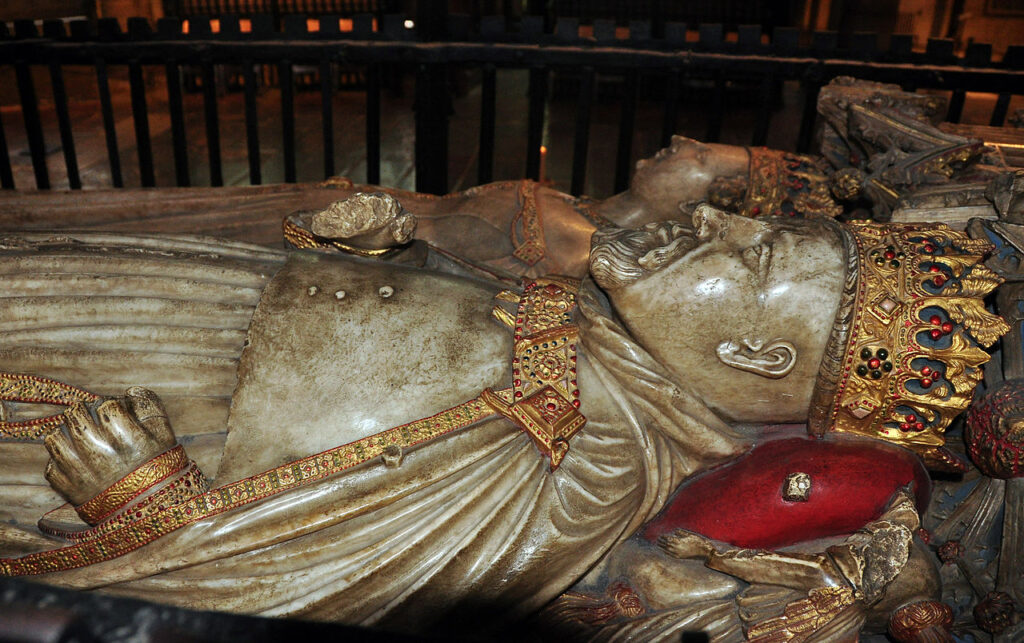
When I started writing the volume about the second half of Henry IV’s life, my inclination was to entitle it The Leper King, only to discover there really was a leper king: Baldwin IV of Jerusalem who died in 1185. And truly, it really wasn’t fair to Henry IV. Yes, he did have some kind of terrible skin disease, though his woes didn’t stop there. But if he really did have leprosy, how did he manage to lead a relatively “normal” existence—without being shunned by his contemporaries? No, apparently something else was going on. It’s nearly impossible to diagnose historical illnesses—especially from over 600 years ago. But historians have come up with some interesting theories.
One of the reasons leprosy achieved such purchase on the medieval mind was the timing of Henry’s first attack. According to many chroniclers, it happened the very night he executed Archbishop Scrope of York for his ill-fated rebellion. No English king had ever executed an archbishop before, and this was a terrible shock to his contemporaries. As the story goes, that very night, Henry woke up shrieking, “Traitors! Traitors! You have thrown fire over me!” His face was burning and he had broken out into a terrible rash—or pustules, or worse. Everyone thought it was God’s retribution for the murder of an archbishop. According to Peter Niven*, “Leprosy was the disease par excellence associated with God’s punishment of sinners”. Did this really happen the night of the execution? So many chroniclers mentioned it, that it would be incautious to dismiss the claim out of hand. Henry was bedridden for a week before he could continue his campaign against the rebel Henry Percy. But once he was back in the saddle, he allegedly carried on with renewed vigor. Temporarily, at least, he recovered—the first argument against leprosy.
There’s always the possibility that the medieval manifestation of leprosy differed from what we currently know as Hansen’s Disease. Nonetheless, the issue seems to have been decided when Henry’s tomb was opened in 1832. Although his remains quickly disintegrated upon exposure to the air, the investigators had enough time to determine that “his skin was intact, his features were not disfigured, and even the all-important nasal cartilage was undamaged” (Peter Niven, again).
It’s the other symptoms that confuse the issue. A little more than a year after his initial illness, Henry was struck with what he referred to as une grande accesse, and at the same time he complained of une maladie in his leg. Unable to ride, he was obliged to travel by barge and missed the first week of the 1406 parliament. Known as The Long Parliament, it lasted most of the year, and it’s thought that the many recesses had to do with his frequent inability to attend. Did he have a stroke? By all indications he retained clarity until his death. Could it be a blood clot in his leg? Historians just don’t know. Although his skin disease came and went for the rest of his life, it was the progressive weakness in his legs and associated attacks that took away his strength and reduced him to an invalid.
Some historians have suggested syphilis, which could account for many of the symptoms. However, the first recorded incidence of this disease hadn’t occurred in Europe before the end of the fifteenth century. Some have suggested psoriasis—possibly psoriatic psoriasis, which included joint inflammation and swelling. Three years after his first attack, Henry was struck down with a sudden seizure so violent that he lost consciousness for quite a few hours; for a while people thought he was dead. A few months later he made his will, which was usually done from the deathbed in this period—or prior to leaving for battle. Apparently he, too, thought he had reached the end. By then, he could barely walk or ride and was mostly carried in a litter or improvised wheelchair. Ultimately, Niven concluded that Henry could well have suffered from coronary heart disease or some sort of circulatory disorder. He suggested that rheumatic heart disease could easily explain his “growing incapacitation, his  occasional dramatic collapses, and his relatively early death.” So, along with this conjecture, the skin disease was an unfortunate condition that had nothing to do with the major collapses that incapacitated him.
occasional dramatic collapses, and his relatively early death.” So, along with this conjecture, the skin disease was an unfortunate condition that had nothing to do with the major collapses that incapacitated him.
We certainly can’t ignore the effects of stress and—let’s face it—possible guilt over the usurpation and execution of an archbishop. Henry had more than his fair share of rebellions to deal with, and unless he was a man without a conscience, he must have had a lot of dead traitors weighing on his mind. I tried to count the numbers of executed men and lost track after about eighty. That’s enough to give most of us agita.
*McNiven, Peter, THE PROBLEM OF HENRY IV’S HEALTH, 1405-1413, The English Historical Review, Vol. 100, no. 397 (Oct. 1985), pp. 747-772